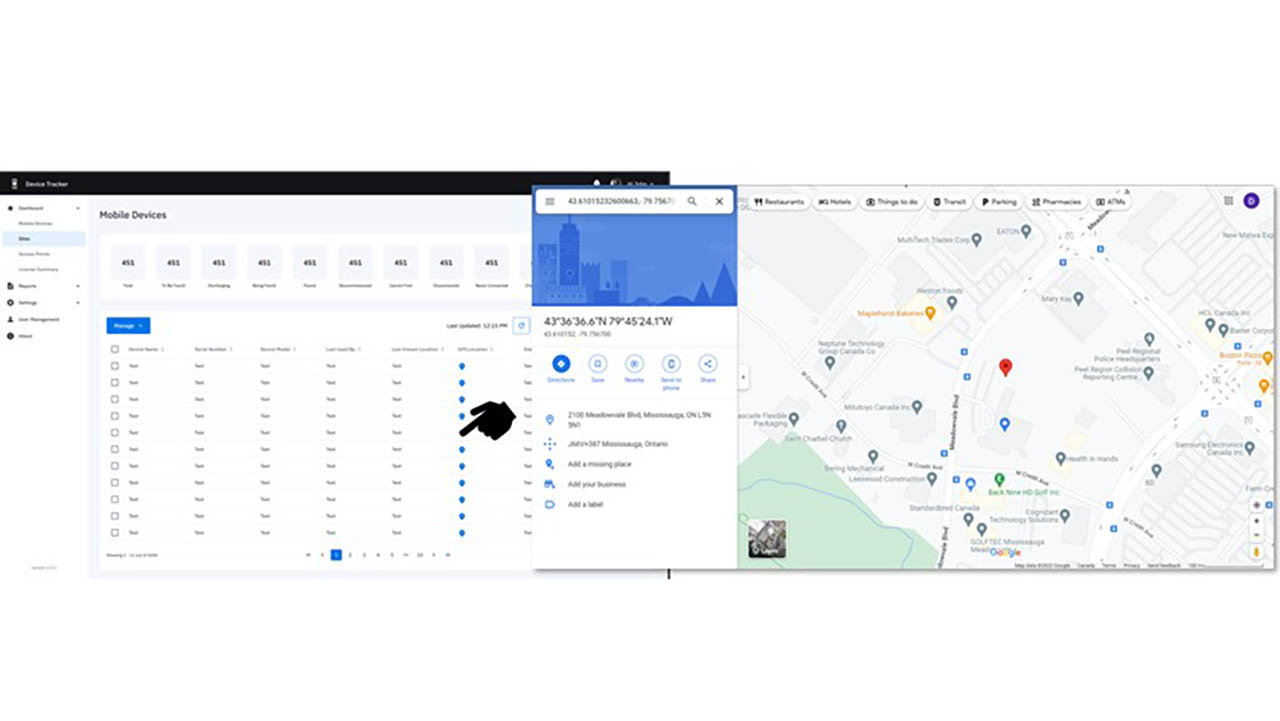Transform retail operations with Zebra’s retail technology solutions, featuring hardware and software for improving inventory management and empowering teams.
Streamline operations with Zebra’s healthcare technology solutions, featuring hardware and software to improve staff collaboration and optimise workflows.
Enhance processes with Zebra’s manufacturing technology solutions, featuring hardware and software for automation, data analysis, and factory connectivity.
Zebra’s transportation and logistics technology solutions feature hardware and software for enhancing route planning, visibility, and automating processes.
Zebra's public sector technology solutions enhance decision-making, streamline operations, and safeguard communities with advanced software and rugged hardware.
Zebra's hospitality technology solutions equip your hotel and restaurant staff to deliver superior customer and guest service through inventory tracking and more.
Zebra's market-leading solutions and products improve customer satisfaction with a lower cost per interaction by keeping service representatives connected with colleagues, customers, management and the tools they use to satisfy customers across the supply chain.
Empower your field workers with purpose-driven mobile technology solutions to help them capture and share critical data in any environment.
Zebra's range of mobile computers equip your workforce with the devices they need from handhelds and tablets to wearables and vehicle-mounted computers.
Zebra's desktop, mobile, industrial, and portable printers for barcode labels, receipts, RFID tags and cards give you smarter ways to track and manage assets.
Zebra's 1D and 2D corded and cordless barcode scanners anticipate any scanning challenge in a variety of environments, whether retail, healthcare, T&L or manufacturing.
Zebra's extensive range of RAIN RFID readers, antennas, and printers give you consistent and accurate tracking.
Choose Zebra's reliable barcode, RFID and card supplies carefully selected to ensure high performance, print quality, durability and readability.
Zebra's rugged tablets and 2-in-1 laptops are thin and lightweight, yet rugged to work wherever you do on familiar and easy-to-use Windows or Android OS.
With Zebra's family of fixed industrial scanners and machine vision technologies, you can tailor your solutions to your environment and applications.
Zebra’s line of kiosks can meet any self-service or digital signage need, from checking prices and stock on an in-aisle store kiosk to fully-featured kiosks that can be deployed on the wall, counter, desktop or floor in a retail store, hotel, airport check-in gate, physician’s office, local government office and more.
Adapt to market shifts, enhance worker productivity and secure long-term growth with AMRs. Deploy, redeploy and optimize autonomous mobile robots with ease.
Discover Zebra’s range of accessories from chargers, communication cables to cases to help you customise your mobile device for optimal efficiency.
Zebra's environmental sensors monitor temperature-sensitive products, offering data insights on environmental conditions across industry applications.
Zebra's location technologies provide real-time tracking for your organisation to better manage and optimise your critical assets and create more efficient workflows.
Enhance frontline operations with Zebra’s AI software solutions, which optimize workflows, streamline processes, and simplify tasks for improved business outcomes.
Empower your frontline with Zebra Companion AI, offering instant, tailored insights and support to streamline operations and enhance productivity.
The everything you need to rapidly and cost effectively develop high-performance AI vision applications on Zebra mobile computers.
Zebra Workcloud, enterprise software solutions boost efficiency, cut costs, improve inventory management, simplify communication and optimize resources.
Keep labour costs low, your talent happy and your organisation compliant. Create an agile operation that can navigate unexpected schedule changes and customer demand to drive sales, satisfy customers and improve your bottom line.
Drive successful enterprise collaboration with prioritized task notifications and improved communication capabilities for easier team collaboration.
Get full visibility of your inventory and automatically pinpoint leaks across all channels.
Reduce uncertainty when you anticipate market volatility. Predict, plan and stay agile to align inventory with shifting demand.
Drive down costs while driving up employee, security, and network performance with software designed to enhance Zebra's wireless infrastructure and mobile solutions.
Explore Zebra’s printer software to integrate, manage and monitor printers easily, maximising IT resources and minimising down time.
Make the most of every stage of your scanning journey from deployment to optimisation. Zebra's barcode scanner software lets you keep devices current and adapt them to your business needs for a stronger ROI across the full lifecycle.
RFID development, demonstration and production software and utilities help you build and manage your RFID deployments more efficiently.
RFID development, demonstration and production software and utilities help you build and manage your RFID deployments more efficiently.
Zebra DNA is the industry’s broadest suite of enterprise software that delivers an ideal experience for all during the entire lifetime of every Zebra device.
Advance your digital transformation and execute your strategic plans with the help of the right location and tracking technology.
Boost warehouse and manufacturing operations with Symmetry, an AMR software for fleet management of Autonomous Mobile Robots and streamlined automation workflows.
The Zebra Aurora suite of machine vision software enables users to solve their track-and-trace, vision inspection and industrial automation needs.
Zebra Aurora Focus brings a new level of simplicity to controlling enterprise-wide manufacturing and logistics automation solutions. With this powerful interface, it’s easy to set up, deploy and run Zebra’s Fixed Industrial Scanners and Machine Vision Smart Cameras, eliminating the need for different tools and reducing training and deployment time.
Aurora Imaging Library™, formerly Matrox Imaging Library, machine-vision software development kit (SDK) has a deep collection of tools for image capture, processing, analysis, annotation, display, and archiving. Code-level customisation starts here.
Aurora Design Assistant™, formerly Matrox Design Assistant, integrated development environment (IDE) is a flowchart-based platform for building machine vision applications, with templates to speed up development and bring solutions online quicker.
Designed for experienced programmers proficient in vision applications, Aurora Vision Library provides the same sophisticated functionality as our Aurora Vision Studio software but presented in programming language.
Aurora Vision Studio, an image processing software for machine & computer vision engineers, allows quick creation, integration & monitoring of powerful OEM vision applications.
Adding innovative tech is critical to your success, but it can be complex and disruptive. Professional Services help you accelerate adoption, and maximise productivity without affecting your workflows, business processes and finances.
Zebra's Managed Service delivers worry-free device management to ensure ultimate uptime for your Zebra Mobile Computers and Printers via dedicated experts.
Find ways you can contact Zebra Technologies’ Support, including Email and Chat, ask a technical question or initiate a Repair Request.
Zebra's Circular Economy Program helps you manage today’s challenges and plan for tomorrow with smart solutions that are good for your budget and the environment.

Hot Update! You Can Now Use Public Maps to Find Your Missing Zebra Mobile Devices.
It’s no secret that Zebra’s Device Tracker is a pretty neat tool. As my colleague Daniel Park demonstrates in this video, you can equip your Zebra mobile devices with Bluetooth Low Energy batteries that emit a signal to other Zebra mobile devices in the area, letting them know where they are if they seem invisible to the human eye:
You can even locate mobile devices that have powered down, which I’ve talked about as well in this previous blog post:
Did You Know? Device Tracker Can Notify You When You Are Near a Zebra Mobile Device That Is Idle Too Long, Going Offline, or Missing.
This easy “finder” tool is why one retailer has been able to reduce its permanent device losses by ~77% across all its stores in just six months! Company leaders say they have only permanently lost two devices since in-store teams started using Device Tracker, and they’ve recovered devices a whopping 476 times using the tool. We are projecting that Device Tracker will reduce the retailer’s overall device loss from 19% to 4.4%, which would result in a 647% return on investment.
Of course, even two missing devices is two too many, so we’ve been looking into ways to get that number down to zero.
We’ve also had some customers ask how they’re supposed to find Zebra devices that are left behind in random places in the field – a restaurant, a customer’s home or business where deliveries are being made or services provided, a rail yard, or even a literal field (where utility infrastructure inspections may be occurring). It’s a great question, as lost/forgotten devices are a very real issue among field-based workers who are always in a hurry and easily distracted. They may drop their device, or intentionally put it down to pick up something else, and then leave, only to realize several hours later that they don’t have their device on them anymore. If the worker covers a lot of ground in a day, it could be quite time consuming to retrace their steps in search of a mobile device. Plus, it would be highly disruptive to business depending on the time of day and how many other deliveries, tickets or tasks need to be completed.
So, our answer to this question (and problem) is map-based locationing.
That’s right.
We’ve added map-based locating capabilities to Zebra Device Tracker so that you (and your panicked employees) can quickly find misplaced mobile computing devices, even those that won’t be pinging off your owned access points as workers move about.
How Map-Based Locate Works
Because Device Tracker is web-based, and the maps used to locate the devices are publicly available tools (i.e., Google Maps), anyone trying to retrieve a missing mobile computing device can access timely information about its whereabouts using any other internet-enabled device.
Once a device is reported missing, whoever has device administrator permissions will be able to look up the device’s last known location on demand using a web dashboard that correlates to Google Maps. Once the coordinates are confirmed, the administrator can point the panicked worker (or whoever is sent to recover the device) in the right direction. Once that person is in the physical vicinity of the device, the device administrator can play a sound to help them find the precise device location. It’s a bit like Marco Polo if you’ve ever played that pool game, where the device is audibly calling out to the worker to reveal its location, and it’s especially helpful if the device is somewhat hidden from view – perhaps in between pallets or in a random place on the ground.
In fact, my colleague was telling me her delivery driver dropped his Zebra device under his truck the other day when he was unloading some boxes. He was lucky it didn’t go far, and he found it quickly after laying on the ground to look for its whereabouts. But what if that device had fallen in a deep ditch and wasn’t so easy to see? He could have been there a long time looking for it.
Speaking of a long time…
“What happens when the device is missing so long that the battery dies?” you’re probably wondering.
As you probably guessed, map-based locations aren’t going to be an option when a device is powered down. That’s why we made several important updates to Device Tracker recently, including the ability to confirm the device’s last known location before someone powered it down or the battery died. More specifically, Device Tracker is now set up to capture the device’s location when certain events occur, including:
A device reboot
Device check-out and check-in
Connection to a new cellular or Wi-Fi network
A change in the charging state (i.e., plugged into or removed from a charger)
A low battery (triggered at whatever threshold you decide to set).
If the device powers down due to battery loss, this last feature is going to be most helpful as Device Tracker will repeatedly report the device’s location as the battery drains – at every 2% drain interval, to be exact. So, if you set the low battery threshold to 10%, you’ll get five updates in a very short period of time, giving you a solid lead on the device’s location (assuming someone hasn’t found it since the battery shut down). Even if a good citizen does happen to stumble upon the device after it has lost power, and they move it from the last reported location, you’ll know where to start your search to recover the device.
Of course, if someone intentionally powered down the device and walked away with it, it’s going to be a little more difficult to locate that device on demand. However, you’ll still be able to collate all the last known locations and have a better chance of finding the person (and device) than if you weren’t getting map-based location updates at all.

In other words, if your workers are constantly on the move and your Zebra devices are often outside the range of your Wi-Fi networks, you’re going to benefit from the new map-based location tracking capabilities of Device Tracker.
If you have more questions about how Device Tracker works overall (in both WAN and LAN environments) or want to confirm that Device Tracker is actively tracking all your deployed Zebra devices today, reach out to me or your local Zebra representative. You should also check out this new video showing you how map-based locationing works (as well as other Device Tracker features):

David Degrassi
David Degrassi is currently a Product Manager at Zebra where he is responsible for Zebra’s Enterprise Mobile Computing Software Solutions.
David has more than 17 years of experience within the mobile industry and has managed Zebra’s Mobility DNA software, including StageNow mobile configuration tool and EMM Toolkit. David currently manages Device Tracker and Enterprise Home as well a host of other valuable utilities such as Device Central and Battery Manager.
Zebra Developer Blog
Zebra Developer BlogZebra Developer Blog
Are you a Zebra Developer? Find more technical discussions on our Developer Portal blog.
Zebra Story Hub
Zebra Story HubZebra Story Hub
Looking for more expert insights? Visit the Zebra Story Hub for more interviews, news, and industry trend analysis.
Search the Blog
Search the BlogSearch the Blog
Use the below link to search all of our blog posts.
Most Recent
Legal Terms of Use Privacy Policy Supply Chain Transparency
ZEBRA and the stylized Zebra head are trademarks of Zebra Technologies Corp., registered in many jurisdictions worldwide. All other trademarks are the property of their respective owners. Note: Some content or images on zebra.com may have been generated in whole or in part by AI. ©2026 Zebra Technologies Corp. and/or its affiliates.




